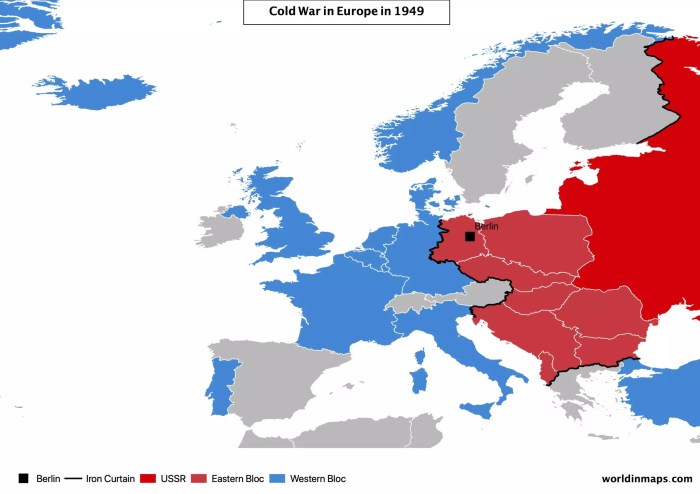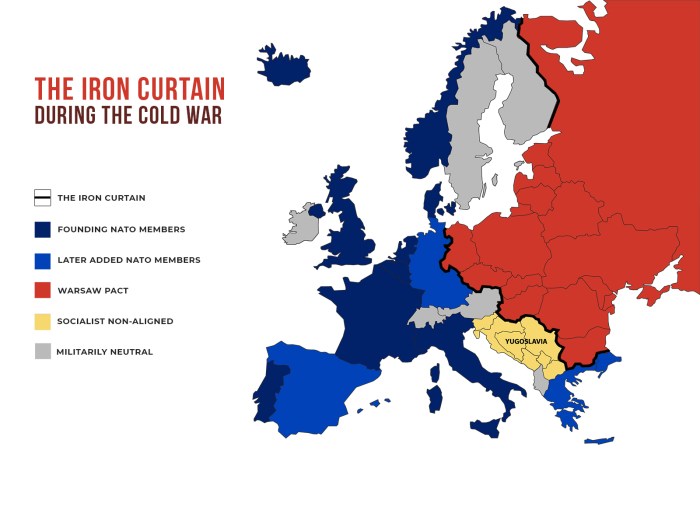Cold war alliances of europe map iron curtain – The Cold War alliances of Europe, symbolized by the infamous Iron Curtain, profoundly shaped the political, ideological, and security dynamics of the continent. This article delves into the formation, goals, and impact of NATO and the Warsaw Pact, exploring their roles in maintaining the balance of power and influencing the course of the Cold War.
The division of Europe into two opposing blocs not only created physical barriers but also had far-reaching consequences for the lives of Europeans and the development of European security institutions.
European Alliances Post-World War II

After World War II, Europe was divided politically and ideologically. The Western powers, led by the United States, supported democracy and capitalism, while the Soviet Union and its allies in Eastern Europe established communist regimes.
In response to the perceived Soviet threat, the United States and its allies formed the North Atlantic Treaty Organization (NATO) in 1949. NATO was a collective defense pact that committed its members to come to the aid of any member that was attacked.
The Soviet Union responded by forming the Warsaw Pact in 1955. The Warsaw Pact was a similar collective defense pact that committed its members to come to the aid of any member that was attacked.
| NATO | Warsaw Pact |
|---|---|
| United States | Soviet Union |
| United Kingdom | Poland |
| France | East Germany |
| West Germany | Czechoslovakia |
| Italy | Hungary |
| Belgium | Romania |
| Netherlands | Bulgaria |
| Luxembourg | Albania |
The Iron Curtain

The Iron Curtain was a term used to describe the political and ideological division between Eastern and Western Europe during the Cold War. The term was first used by Winston Churchill in a speech in 1946.
The Iron Curtain was both a physical and a symbolic barrier. Physically, it consisted of a series of fortified borders and checkpoints that prevented people from crossing from one side of the Curtain to the other.
Symbolically, the Iron Curtain represented the division between two different worlds: the democratic West and the communist East.
The Iron Curtain had a profound impact on the lives of Europeans. It divided families and friends, and it made it difficult for people to travel and communicate across the Curtain.
Key Alliances within NATO and the Warsaw Pact, Cold war alliances of europe map iron curtain
NATO and the Warsaw Pact were both dominated by their respective superpowers, the United States and the Soviet Union. However, each alliance also had its own unique members and characteristics.
The United States was the most important member of NATO. It provided the alliance with its military and economic power.
The United Kingdom was another important member of NATO. It provided the alliance with its naval and air power.
France was a founding member of NATO, but it withdrew from the alliance’s military structure in 1966. However, France remained a member of NATO’s political structure.
The Soviet Union was the most important member of the Warsaw Pact. It provided the alliance with its military and economic power.
Poland was another important member of the Warsaw Pact. It provided the alliance with its strategic location on the border with Germany.
East Germany was a founding member of the Warsaw Pact. It provided the alliance with its military and economic power.
The Impact of the Cold War on European Security

The Cold War had a profound impact on the security landscape of Europe. The two superpowers, the United States and the Soviet Union, were constantly competing for influence and power, and this competition often played out in Europe.
The Cold War alliances shaped the security landscape of Europe in a number of ways. First, they divided Europe into two hostile blocs, and this division made it difficult to resolve conflicts peacefully.
Second, the Cold War alliances led to a massive arms buildup in Europe, and this arms buildup increased the risk of war.
Third, the Cold War alliances made it difficult for European countries to cooperate on security issues, and this made it more difficult to address common threats, such as terrorism and organized crime.
FAQ Compilation: Cold War Alliances Of Europe Map Iron Curtain
What was the purpose of NATO?
NATO (North Atlantic Treaty Organization) was established in 1949 as a defensive alliance to protect its member states from potential Soviet aggression.
What was the significance of the Iron Curtain?
The Iron Curtain, a term coined by Winston Churchill, represented the physical and ideological division of Europe between the Soviet-dominated Eastern bloc and the Western bloc.
How did the Cold War alliances impact European security?
The Cold War alliances created a balance of power that deterred direct military conflict between NATO and Warsaw Pact member states, but also contributed to tensions and mistrust.
